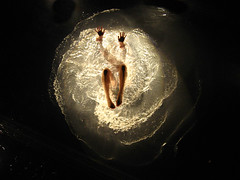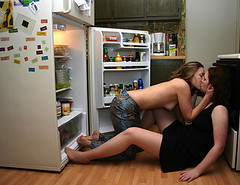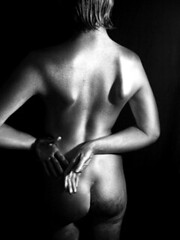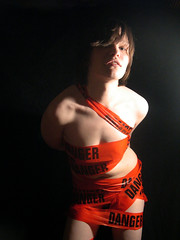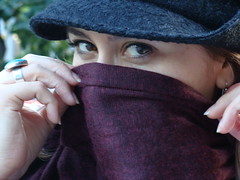Watching Objects Objects' Watching
Chavisa Woods on the Girleye Show Entering ‘World Feminisms', the inaugural exhibition for the Elizabeth Sackler Center at the Brooklyn Museum, some years ago, I overheard a fifty-something white suit whispering to his viewing partner that he was “So tired of women trying to pass their bodies off as art.” I wondered, but unfortunately did not ask, what the man thought of endless centuries of men “trying to pass” women’s bodies off as art. John Berger, speaking of the use of the female body in classical nudes noted, “Men act and women appear. Men look at women. Women watch themselves being looked at.” Berger claimed that a man’s presence in an image was suggestive of what he was capable of doing to you, while the woman’s presence was suggestive of what she would or would not allow to be done to her.
The artists in the Girleye Show make no apologies for ‘trying to pass their bodies off as art,’ simultaneously occupying spaces as object, appearing- yes, being watched- yes, yet actively so. These women are watching themselves being watched, but not as a suggestion of what they might allow to be done to them; they watch themselves being watched as an acknowledgement of what has been done to them, and, like the subaltern abjuring their position by speaking, through the appearance of active acknowledgement, they suggest what they are capable of doing to you, the viewer and, more importantly, what they are capable of doing to and for themselves. I have always interpreted Berger’s quote as not only speaking of identity of the art object, but also of the identity of the female viewer looking at themselves as passive art objects. In Lauren Goldberg’s "Looking Glass", a woman leans into the viewer, peering through a magnifying lens, her right eye dominating her gaze. Berger’s formational notion is exemplified with an ironic twist, the object of the art is not quite watching herself being watched, but watching the viewer watch her; a subtle but volatile difference. In this piece, the audience is acknowledged and challenged.
The socio-historical relevance of the content of the pieces included in the Girleye show might be the first thing one notices when entering the exhibition, but it definitely will not be the last. The structure and skill pervading the anatomy of the photographs pull the pieces beyond a political narrative steeped in, for some, (not for me), a daunting haze of feminist identity politics, into a complexity of diverse narratives and visual constructions. If not, how could they ‘pass their bodies off as art’ so convincingly?
Beth Hommel’s Palms and Knees catches the viewer with a stunning play of light on water. The black and white ripples of the wave outward from the center create perhaps an ominous flower, the stigma (flower’s center) of which being a woman drowning, or perhaps she is reaching out, being born from the center of the thing so indicative of a flower, which also posses a stigma of another sort. These invocations inferred simultaneously are not necessarily the ultimate culmination of the work; an immediate and lasting visual image.
This image is a departure from the other of Hommel’s works included in the exhibition- for instance, Caress, which shows the torsos of two women in muffin-like dresses enjoying an intimate embrace, and Kitchen, displaying two woman in a kinetic moment of passion in front of an open refrigerator door; photos presenting a narrative between two characters whose relationships to one another are cast in as unambiguous a light as the vibrant colors saturating the print.
Cassie Olander mediates on texture, using skin as her canvas in two pieces, Silver and Vulnerability. Ultimately she presents us with compelling and resolute portraiture in Reaching, Contemplative, Bubbly, and Danger. These are obviously not snapshots, but simple scenes set to capture the character of the subjects, which she has done clearly, simply, with incisive precision. In all but Danger, you walk away with the feeling of having been privy to something very intimate of the subjects. With Danger, a nude woman wrapped in police tape, the statement made is indicative more of the person as an identity than the identity of the person, yet not any less relevant than the former.
Anne Marie Hansen, on the other hand, has depicted, beautifully, human movement and photographic motion with what appear to be a series of unrehearsed snapshots. Swimmers depicts, as you can guess, four women swimming. The shot is rendered from high above, a godlike position of viewing. This black and white image recalls tales of sirens. Miss Mercier is a snapshot of a woman covering her face with a scarf, the top half of her face obscured by a hat. Her eyes are smiling at us. This is a seemingly simple scene. The narrow slot through which the eyes gaze is reminiscent of a veil, yet the covering of her face creates a greater intimacy and provocation than would have been present if her full face had remained un-obscured.
Finally, Lauren Goldberg presents us with a series of lush images, some snapshots, some constructed scenes. The line present throughout all of the images is the vigilance of the artist. Whether rehearsed or on the fly, Goldberg has captured the exact moment, the exact scene that will invoke a complex visceral response, while remaining loyal to a contract of beauty so often broken when content borders on disturbing. I shy away from calling the images poetic. They do not rhyme. There is no final stanza. Rather, they are each a series of chords stuck at once, creating a discord in which the mind is able to find some harmony. I will not describe them to you, but make especially sure to view Distance, Stairs and Crying Statue.
In the Girleye Show, woman act, women appear and disappear, watch you watching, watch themselves being watched and know what they can do. Janet Bruesselbach has brought together a robust group of artists whose works compliment one another, while promising that around the next corner you will find a new and varied angle from which to approach the art you are currently practicing; the art of looking.


